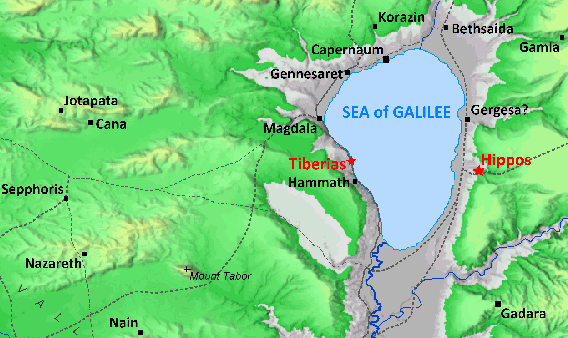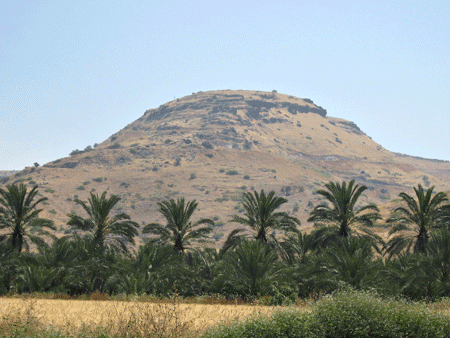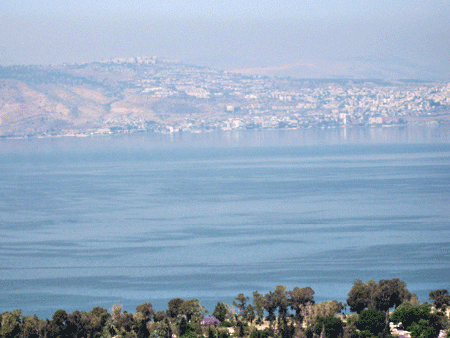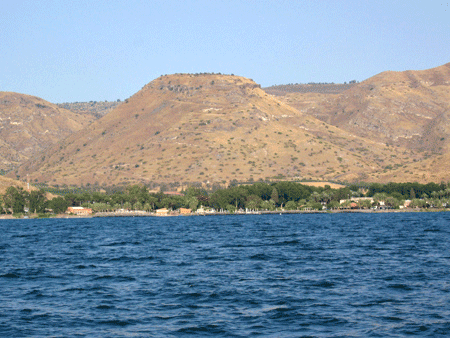|
 |
|
 |
|
|
Which city "on a hill" is Jesus referring to? It’s
certainly not San Francisco, or even
Tiberias or Safed, for that matter.
Tiberias in Jesus’ day stretched along the
shore
of the Sea of Galilee, from the hot
springs northwards. And Safed in the
Upper Galilee was not yet a city, only a
fort. |
|
|
|
 |
|
Copyright 2012 by
Gila Yudkin |
|
Map of Galilee -- towns and
villages in Jesus' day |
|
| Hippos, a hill with a horse-shaped neck
(admittedly one needs a great deal of
imagination to see this!), across from the
Mount of Beatitudes on the eastern side of
the Sea of Galilee, seems to be our best
candidate. Its white limestone and
marble buildings would have been gleaming
and beckoning in the eyes of a crowd
standing on a western hillside above the Sea
of Galilee, especially as the afternoon sun
dipped down towards the Mediterranean. |
|
|
 |
|
Photo:
Gila Yudkin |
|
The ruins of Hippos can be
found at the top of the rounded hill |
|
Hippos belonged to a league of 10 Greek
cities called the Decapolis. Each city
had civic independence from its local ruler
and even held the right to mint its own
coins. Hippos is believed to have boasted a
large theater, an Odeon (a smaller 600-seat
theater for musical performances), a
nymphaeum with fountains dedicated to water
nymphs, and stately pagan temples to Zeus,
Aphrodite and perhaps even Dionysus.
The inhabitants of Hippos (shall we call
them Hippies?) believed that their gods –
and there were dozens – schemed, squabbled,
copulated and manipulated. This is
quite a contrast to the Jewish farmers and
fishermen who believed in One God who
championed the poor, the meek and the
downtrodden. |
|
|
 |
|
Photo:
Gila Yudkin |
|
Main Street Hippos from
the Roman times |
|
|
From Hippos, perched a thousand feet above
the Sea of Galilee, we have a commanding
view of the area where the man possessed by
demons dwelled among the tombs. Jesus
cast the demons into a herd of swine who
charged down the cliff into the sea to
drown. One would naturally find pigs
on the pagan, (non-kosher) side of the lake.
“So the man went away and began to tell in
the Decapolis how much Jesus had done for
him.” (Mark 5:20) The first city in
the Decapolis the demoniac would have
reached would be Hippos. |
|
|
 |
|
Photo:
Gila Yudkin |
|
Across the lake from Hippos, Tiberias on
the western shore is visible |
|
Not having visited Hippos since excavations
began in the year 2000, I decided to take
advantage of a free day to update myself.
I approached Hippos the traditional way we
always did, from the Golan Heights on the
east. My trusty fire-engine-red
Daihatsu negotiated the many hairpin turns
along the old Syrian/Jordanian border quite
gracefully.
I alternated between observing the old
pre-1967 Syrian bunkers once shielding its
gunmen beside each curve to watching for a
speeding car careening from the opposite
direction. At the top of the ascent my
senses were assaulted first by golden fields
of wheat, and then by a strong whiff of
scallions and garlic.
Finally I turned west onto a deeply rutted
agricultural road which is unfortunately
forbidden to tour buses. On either
side of the road are signs warning, “Danger
mines.” After a steep descent of two
miles, I recognized the protruding black
basalt rocks of Hippos, which did not look
like a horse at all. |
|
|
|
 |
|
Photo:
Gila Yudkin |
|
Approach to the Decapolis
city from the southeast in 2010 |
|
|
|
Climbing up a path into the city, I found
myself walking along a long stretch of the
original basalt paved avenue, similar to
Main Street, Beth Shean (Scythopolis).
Archeologists have recently uncovered a
number of public buildings, temples or
churches with apses facing east. Many
long reddish and grayish granite columns,
imported from Egypt, were strewn about. |
|
|
|
 |
|
Photo:
Gila Yudkin |
|
Ruins from a public
building at Hippos, perhaps a pagan temple
or church |
|
|
|
It’s exciting to walk in solitude through a
site where the archeologists’ spade is
adding flesh to the historical skeleton.
One’s imagination starts to work overtime. I
had read that during the last season, three
clay statues of Aphrodite, each nearly a
foot long, had been discovered.
Aphrodite was the Greek goddess of love,
fertility and childbirth. Her temples were
pilgrimaged by young maidens seeking true
love, as well as by pregnant women praying
for a safe birth. |
|
|
|
As I rambled, my eyes strayed to the Sea of
Galilee and I thought of the Galilean
fishermen looking across to this
ostentatious metropolis crowned with pagan
temples dedicated to Zeus and Aphrodite.
Then I contemplated the words of the great
historical geographer George Adam Smith: |
|
|
“The Decapolis city overhanging the
Lake of Galilee which sent its scholars to
Greece and Rome proves that the Kingdom of
God came forth in no obscure corner, but
in the face of the kingdoms of this
world.”
|
|
 |
|
Photo:
Gila Yudkin |
|
Hippos as seen from a
fishing boat sailing the Sea of Galilee |
|
|
|
At the present moment, Hippos is not
accessible by tour bus, but hope springs
eternal that the road from the sea up to the
site will be renovated soon. And if
you want to really go off the beaten path in
Galilee, you can book a jeep tour up from
the sea to the Golan Heights which includes
a ramble through Hippos. It’s not
cheap, but intensely memorable and tons of
fun for the young in spirit. |
|
|
Postscript July 2024 |
|
|
In the mid-July heat wave of 2024 I
revisited Hippos. To my delight it now has a
parking lot, a long fairly easy stepped
pathway to the summit and bathrooms! |
|
 |
|
Photo:
Gila Yudkin |
|
A fairly easy ascent to
Hippos today with segments of the old
aqueduct in center |
|
 |
|
Photo:
Gila Yudkin |
|
Approach to the Decapolis
city from the southeast in 2024 |
|
|
The eastern city gate complex has been
excavated and segments of the 24-km aqueduct
have been exposed. As you walk along
the Decumanus Maximus, the colonnaded
east-west main drag, it’s fun to look for
the original chiseling marks on every fifth
stone, carved by stone masons a millennium
and a half ago. The marks are Greek
characters, indicating the identity of the
contractor who brought the heavy stones from
the quarries and was paid according to the
number of stones he supplied. |
|
|
 |
|
Photo:
Gershon Grinblatt |
|
Standing by the eastern
gate which protected the city from assault |
|
|
Besides the panoramic view over the sea, I
was most impressed by the ruins of the Roman
Odeon, a small once roofed theater seating
only a few hundred people used for musical
recitals and poetry readings. You
really feel that you are in a pagan city of
the Decapolis, the league of ten
semi-autonomous Roman-Greek cities. |
|
|
 |
|
Photo:
Gila Yudkin |
|
Looking westwards towards
the Odeon and the Sea of Galilee |
|
|
 |
|
Photo:
Gila Yudkin |
|
Northern wall of the
Odeon, a small theater for poetry reading |
|
|
 |
|
Photo:
Gila Yudkin |
|
Excavating the long buried
ruins of Hippos, the "city on a hill which
cannot be hid" |
|
|
As I explored the site, I came upon Arleta
who has been working on the dig for six
seasons. This time she was supervising
18 volunteers of all ages from Taiwan to
Kentucky who were digging in the western
section of Hippos. She asked me not to
photograph one specific area because they
had found something very special, but hadn’t
publicized it yet. Stay tuned! |
|
|
Copyright 2010, 2012, 2024 Gila Yudkin. Permission
needed for any reuse. |
|
|
|
Gila Yudkin,
who calls herself a Connecticut-born Yankee
living in King David’s court, is always on
the lookout for new angles on ancient sites.
She loves working with groups thirsty for
biblical insight, archeological anecdotes
and old-fashioned fun. She wishes she
could have toured with George Adam Smith in
1880, or been Mark Twain’s tour guide way
back in 1867. |
|
|
|
You may be familiar with another Decapolis
city, Beth Shean called Scythopolis in the
Roman period. For its biblical past,
see "Let's
lament King Saul at Beth Shean." |
|
|

